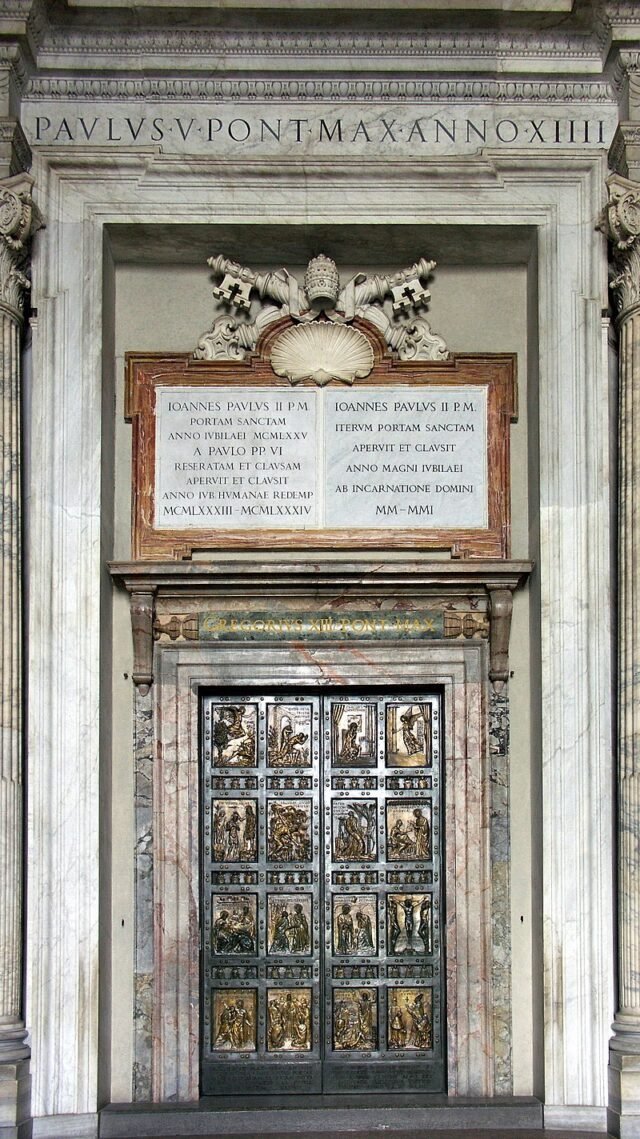The Holy Doors of Rome, deeply rooted in Catholic tradition, are central to the Jubilee 2025 celebrations. These sacred doors, located in the Papal Basilicas of St. Peter’s, St. John Lateran, St. Mary Major, and St. Paul Outside the Walls, symbolize spiritual renewal, forgiveness, and entry into God’s grace. They are opened only during Jubilee years, making their unsealing in 2025 a highly anticipated event.
The Holy Door—Latin: Porta Sancta—is not merely a physical gateway but a profound symbol of the soul’s journey toward reconciliation and salvation. Passing through these doors grants a plenary indulgence, offering pilgrims a remission of temporal punishment for sin. This act reflects the passage from sin to grace and is a powerful expression of faith and repentance.
History of the Holy Doors
The tradition of the Holy Door began in 1423 under Pope Martin V, though the Jubilee practice itself dates to 1300, established by Pope Boniface VIII. Initially, the Holy Door was sealed with bricks and mortar, ceremonially broken by the Pope at the start of the Jubilee and rebuilt at its close. This physical act emphasized the solemnity of crossing the threshold into a year of mercy and grace.
Each Holy Door holds a rich history. For example, the door of St. Peter’s Basilica, installed by Pope Pius XII in 1950, is made of bronze and adorned with 16 intricate panels illustrating biblical scenes and papal emblems. Its design reflects the grandeur and spirituality of the Jubilee tradition.
In 1500, Pope Alexander VI expanded the rite to include Holy Doors at St. Mary Major and St. Paul Outside the Walls, ensuring pilgrims could experience this grace at multiple sites. Over time, the opening of the Holy Doors has been linked to extraordinary Jubilees, such as the Jubilee of Mercy in 2015, when Pope Francis extended this privilege to diocesan Holy Doors worldwide.
Symbolism of the Holy Door
The Holy Door represents a passage to divine mercy and hope, echoing Christ’s words in John 10:9: “I am the door. Whoever enters through me will be saved.” It is a visual reminder of conversion and reconciliation, calling pilgrims to make peace with God, renew their hearts, and embrace a life of grace.
As Pope John Paul II stated during the Great Jubilee of 2000, the Holy Door “evokes the passage from sin to grace,” inviting believers into deeper communion with Christ. Its opening and the pilgrimage it entails signify an opportunity to begin anew.
Pilgrimage to the Holy Doors in 2025
To participate in the Jubilee 2025 pilgrimage to the Holy Doors, visitors will need the Pilgrim’s Card, a free digital pass that grants access to over 35 events, including entry to the Holy Doors. This card, available via the “Iubilaeum25” app or the official Jubilee website, helps organize pilgrim itineraries, ensuring a seamless and spiritually enriching experience.
The Holy Doors will be the focal points of pilgrimage routes designed to guide the faithful through Rome’s sacred heritage. These paths will include stops at St. Peter’s Basilica, where the Jubilee begins, and the other major basilicas, each representing a unique aspect of Catholic spirituality.
While Rome remains the spiritual heart of the Jubilee, Pope Francis has expanded the tradition by designating Holy Doors in dioceses worldwide, allowing Catholics unable to travel to Rome to participate in the grace of the Holy Year. This inclusivity reflects the Church’s mission to bring God’s mercy to every corner of the world.
As the Holy Doors open in 2025, they will become the gateway for millions to encounter God’s mercy, reminding all that faith is a journey—both physical and spiritual—toward hope, renewal, and eternal grace.










